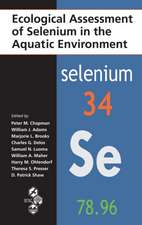One Century of the Discovery of Arsenicosis in Latin America (1914-2014) As2014: Proceedings of the 5th International Congress on Arsenic in the Environment, May 11-16, 2014, Buenos Aires, Argentina: Arsenic in the Environment - Proceedings
Editat de Marta I. Litter, Hugo B. Nicolli, Martin Meichtry, Natalia Quici, Jochen Bundschuh, Prosun Bhattacharya, Ravi Naiduen Limba Engleză Hardback – 8 apr 2014
The session topics comprised:
Theme 1: Arsenic in environmental matrices (air, water and soil)
Theme 2: Arsenic in food
Theme 3: Arsenic and health
Theme 4: Removal technologies
Theme 5: Mitigation management and policy
Hosting this Congress in Argentina was especially relevant because 2014, marks 100 years since the discovery of the disease Hidroarsenicismo Crónico Regional Endémico (HACRE) or arsenicosis by Dr. Goyenechea and Dr. Ayerza in the city of Bell Ville, Province of Córdoba, Argentina. Dr. Ayerza was the first person to relate skin disorders to the consumption of groundwater with high concentrations of arsenic. It is estimated that more than 14 million people in Latin America are at risk, of whom nearly 4 million are exposed to drinking water with high arsenic concentration in Argentina, and further in Chile, El Salvador, Mexico, Nicaragua and Peru. A vast area of the Chaco-Pampean Plain in Argentina, mostly in the semi-arid regions, is affected not only by arsenic exposure from drinking water but also through other exposure pathways, e.g. through food and other dietary intake. The Congress has gathered professionals involved in different segments of interdisciplinary research in an open forum, and strengthens relations between academia, industry, research laboratories, government agencies and the private sector to share an optimal atmosphere for exchange of knowledge, discoveries and discussions about the problem of arsenic in the environment.
| Toate formatele și edițiile | Preț | Express |
|---|---|---|
| Paperback (1) | 272.50 lei 6-8 săpt. | |
| CRC Press – 27 sep 2018 | 272.50 lei 6-8 săpt. | |
| Hardback (1) | 703.08 lei 6-8 săpt. | |
| CRC Press – 8 apr 2014 | 703.08 lei 6-8 săpt. |
Preț: 703.08 lei
Preț vechi: 1002.86 lei
-30% Nou
Puncte Express: 1055
Preț estimativ în valută:
134.55€ • 139.95$ • 111.08£
134.55€ • 139.95$ • 111.08£
Carte tipărită la comandă
Livrare economică 14-28 aprilie
Preluare comenzi: 021 569.72.76
Specificații
ISBN-13: 9781138001411
ISBN-10: 1138001414
Pagini: 990
Dimensiuni: 174 x 246 x 56 mm
Greutate: 1.7 kg
Ediția:New.
Editura: CRC Press
Colecția CRC Press
Seria Arsenic in the Environment - Proceedings
ISBN-10: 1138001414
Pagini: 990
Dimensiuni: 174 x 246 x 56 mm
Greutate: 1.7 kg
Ediția:New.
Editura: CRC Press
Colecția CRC Press
Seria Arsenic in the Environment - Proceedings
Cuprins
The topics covered in As 2014 are grouped under the following general areas:
Theme 1: Arsenic in environmental matrices (air, water and soil)
Theme 2: Arsenic in food
Theme 3: Arsenic and health
Theme 4: Removal Technologies
Theme 5: Mitigation Management and Policy
Theme 1: Arsenic in environmental matrices (air, water and soil)
Theme 2: Arsenic in food
Theme 3: Arsenic and health
Theme 4: Removal Technologies
Theme 5: Mitigation Management and Policy
Descriere
Arsenic has been an issue of concern since decades because of the serious incidence on human health coming from ingestion of water with small amounts of arsenic for prolonged periods.
The presence of Arsenic in water, intended for drinking, has caused the spread of arsenicosis, a set of signs and symptoms manifested mainly by dermatological disorders, such as melanodermia, leucodermia and/or palmoplantar keratoderma, which may evolve into more serious pathologies, such as different types of cancer. The affected populations usually live in countries with low-income levels, and the disease largely affects dispersed rural and periurban populations. Around 100 million people are at risk in Asia and it is estimated that in Latin America the population at risk exceeds 14 million people, with high incidence in Argentina (about 4 million people), Chile, El Salvador, Mexico, Nicaragua and Peru. In the rest of the world, the most affected countries are India, China and Bangladesh, although the presence of arsenic in groundwater has been also found in some European countries and in the United States.
The presence of Arsenic in water, intended for drinking, has caused the spread of arsenicosis, a set of signs and symptoms manifested mainly by dermatological disorders, such as melanodermia, leucodermia and/or palmoplantar keratoderma, which may evolve into more serious pathologies, such as different types of cancer. The affected populations usually live in countries with low-income levels, and the disease largely affects dispersed rural and periurban populations. Around 100 million people are at risk in Asia and it is estimated that in Latin America the population at risk exceeds 14 million people, with high incidence in Argentina (about 4 million people), Chile, El Salvador, Mexico, Nicaragua and Peru. In the rest of the world, the most affected countries are India, China and Bangladesh, although the presence of arsenic in groundwater has been also found in some European countries and in the United States.
Notă biografică
Marta Litter ( 1946) is Doctor in Chemistry from the University of Buenos Aires (1974) is now Head of the Remediation Technologies Division, Chemistry Management, National Atomic Energy Commission, Argentina, Principal Researcher of the National Research Council of Argentina (CONICET) and Full Professor of the National University of General San MartÃn, Argentina. She is author of more than 150 scientific publications. She is director of several degree, master and PhD Thesis. She received twice the Mercosur Prize in Science and Technology. She has been also a coauthor of the Glossary of terms used in photocatalysis and radiocatalysis, IUPAC Recommendations 2010, published in Pure and Applied Chemistry. She has been Leader Editor of a Special Number of Journal of Hazardous Materials in Nanotechnologies for water, air and soil treatment.





















